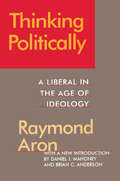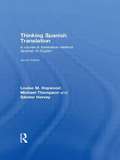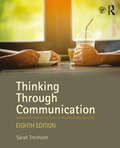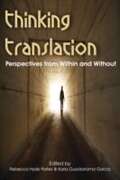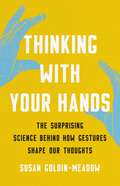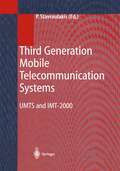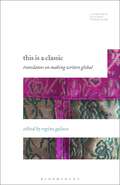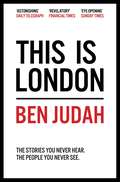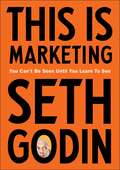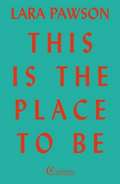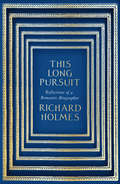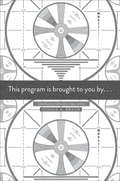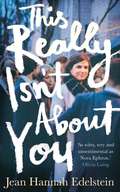- Table View
- List View
Thinking Politically: Liberalism in the Age of Ideology
by Raymond AronThinking Politically brings together a series of remarkable interviews with Raymond Arn that form a political history of our time. Ranging over an entire lifetime, from his youthful experience with the rise of Nazi totalitarianism in Berlin to the dénouement of the cold war. Aron mediates on the threats to liberty and reason in the bloody twentieth century. Originally published as The Committed Observer, this volume provides one of the fullest accounts available of the dramatic events of the "short century," which began with the pistol shot in Saravejo in 1914 and ended with the collapse of the ideological monsters whose deadly nature Aron had ruthlessly exposed for a half-century. In addition to the interviews published in the original edition. Thinking Politically incorporates three interviews never before published in book form. This supplemental material clarifies Aron's role as a voice of prudential reason in an unreasonable age and allows unparalled access to the principal influences on Aron's thought. The volume concludes with 'Democratic States and Totalitarian States," an address by Aron to the French Philosophical Society as well as the accompanying debate with Jacques Maritain, Victor Basch, and other intellectuals. Thinking Politically serves as an ideal gateway into Aron's reflections, and offers a superb single-volume introduction to the major events and conflicts of the twentieth century. It will be a welcome addition to the libraries of political theorists, historians, sociologists, philosophers, and citizens wishing to understand the political and intellectual currents of the age.
Thinking Spanish Translation: Spanish to English
by Louise Haywood Sándor Hervey Michael ThompsonThe new edition of this comprehensive course in Spanish-English translation offers advanced students of Spanish a challenging yet practical approach to the acquisition of translation skills, with clear explanations of the theoretical issues involved. A variety of translation issues are addressed, including: cultural differences register and dialect grammatical differences genre. With a sharper focus, clearer definitions and an increased emphasis on up-to-date 'real world' translation tasks, this second edition features a wealth of relevant illustrative material taken from a wide range of sources, both Latin American and Spanish, including: technical, scientific and legal texts journalistic and informative texts literary and dramatic texts. Each chapter includes suggestions for classroom discussion and a set of practical exercises designed to explore issues and consolidate skills. Model translations, notes and suggestions for teaching and assessment are provided in a Teachers' Handbook; this is available for free download at http://www. routledge. com/cw/thinkingtranslation/ Thinking Spanish Translationis essential reading for advanced undergraduate and postgraduate students of Spanish and translation studies. The book will also appeal to a wide range of language students and tutors through the general discussion of the principles and purposes of translation. 9781134070183 9780415481304 9780203886014 9780415440042
Thinking Spanish Translation: Spanish to English (PDF)
by Louise Haywood Sándor Hervey Michael ThompsonThe new edition of this comprehensive course in Spanish-English translation offers advanced students of Spanish a challenging yet practical approach to the acquisition of translation skills, with clear explanations of the theoretical issues involved. A variety of translation issues are addressed, including: cultural differences register and dialect grammatical differences genre. With a sharper focus, clearer definitions and an increased emphasis on up-to-date 'real world' translation tasks, this second edition features a wealth of relevant illustrative material taken from a wide range of sources, both Latin American and Spanish, including: technical, scientific and legal texts journalistic and informative texts literary and dramatic texts. Each chapter includes suggestions for classroom discussion and a set of practical exercises designed to explore issues and consolidate skills. Model translations, notes and suggestions for teaching and assessment are provided in a Teachers' Handbook; this is available for free download at http://www. routledge. com/cw/thinkingtranslation/ Thinking Spanish Translationis essential reading for advanced undergraduate and postgraduate students of Spanish and translation studies. The book will also appeal to a wide range of language students and tutors through the general discussion of the principles and purposes of translation. 9781134070183 9780415481304 9780203886014 9780415440042
Thinking Through Communication: An Introduction to the Study of Human Communication
by Sarah TrenholmNow in its eighth edition, Thinking Through Communication provides a balanced introduction to the fundamental theories and principles of communication. It explores communication in a variety of contexts—from interpersonal to group to mass media—and can be used in both theoryand skills-based courses. With a dynamic approach, Trenholm helps students to develop a better understanding of communication as a field of study, as well as its practical applications. This edition devotes attention to how new technologies are changing the ways we think about communication, with revised chapters on both traditional and social media.
Thinking Through Communication: An Introduction to the Study of Human Communication (Mycommunicationkit Ser.)
by Sarah TrenholmNow in its eighth edition, Thinking Through Communication provides a balanced introduction to the fundamental theories and principles of communication. It explores communication in a variety of contexts—from interpersonal to group to mass media—and can be used in both theoryand skills-based courses. With a dynamic approach, Trenholm helps students to develop a better understanding of communication as a field of study, as well as its practical applications. This edition devotes attention to how new technologies are changing the ways we think about communication, with revised chapters on both traditional and social media.
Thinking Through Communication: An Introduction to the Study of Human Communication
by Sarah TrenholmThe ninth edition of this textbook for hybrid introductory communication courses provides a balanced introduction to the fundamental theories and principles of communication. The book explores communication in a variety of contexts—including interpersonal, group, organizational, and mass media—and provides students the theoretical knowledge and the research and critical thinking skills they’ll need to succeed in advanced communication courses and professions. The first section explores the history of communication study and explains basic perspectives used by scholars in the field. The second looks at how communicators decode and encode messages, while the third examines channels and contexts, from interpersonal to mass media. This edition devotes attention to how new technologies are changing the ways we think about communication, with revised and updated examples, and gives special attention to relevant critical theory. Two appendices give users the flexibility to tailor their courses to the interests and needs of their students, offering guidelines for preparing and presenting public presentations and giving examples of major research methods. Thinking Through Communication is an ideal textbook for Introduction to Communication courses that aim to provide a comprehensive overview of the field. A companion website for instructors containing PowerPoint slides, test questions, and an instructor’s manual is available at https://routledgetextbooks.com/textbooks/9780367857011.
Thinking Through Communication: An Introduction to the Study of Human Communication
by Sarah TrenholmThe ninth edition of this textbook for hybrid introductory communication courses provides a balanced introduction to the fundamental theories and principles of communication. The book explores communication in a variety of contexts—including interpersonal, group, organizational, and mass media—and provides students the theoretical knowledge and the research and critical thinking skills they’ll need to succeed in advanced communication courses and professions. The first section explores the history of communication study and explains basic perspectives used by scholars in the field. The second looks at how communicators decode and encode messages, while the third examines channels and contexts, from interpersonal to mass media. This edition devotes attention to how new technologies are changing the ways we think about communication, with revised and updated examples, and gives special attention to relevant critical theory. Two appendices give users the flexibility to tailor their courses to the interests and needs of their students, offering guidelines for preparing and presenting public presentations and giving examples of major research methods. Thinking Through Communication is an ideal textbook for Introduction to Communication courses that aim to provide a comprehensive overview of the field. A companion website for instructors containing PowerPoint slides, test questions, and an instructor’s manual is available at https://routledgetextbooks.com/textbooks/9780367857011.
Thinking Translation: Perspectives From Within And Without: Conference Proceedings, Third Uea Postgraduate Translation Symposium
by Rebecca Hyde Parker Karla GuadarramaThinking with Your Hands: The Surprising Science Behind How Gestures Shape Our Thoughts
by Susan Goldin-MeadowAn astounding account of how gesture, long overlooked, is essential to how we learn and interact, which &“changes the way you think about yourself and the people around you.&” (Ethan Kross, bestselling author of Chatter) We all know people who talk with their hands—but do they know what they&’re saying with them? Our gestures can reveal and contradict us, and express thoughts we may not even know we&’re thinking. In Thinking with Your Hands, esteemed cognitive psychologist Susan Goldin-Meadow argues that gesture is vital to how we think, learn, and communicate. She shows us, for instance, how the height of our gestures can reveal unconscious bias, or how the shape of a student&’s gestures can track their mastery of a new concept—even when they&’re still giving wrong answers. She compels us to rethink everything from how we set child development milestones, to what&’s admissible in a court of law, to whether Zoom is an adequate substitute for in-person conversation. Sweeping and ambitious, Thinking with Your Hands promises to transform the way we think about language and communication.
Third Generation Communication Systems: Future Developments and Advanced Topics
by Jian-Guo MaBeside technological issues, this book discusses the administrative and industrial aspects of third generation mobile communications. The authors emphasize existing problems and propose solutions. They provide the most comprehensive and topical information on 3G mobile communications currently available. As the first wave of third-generation communication devices arrives, technological and societal effects will be widespread. The ability to communicate via hand-held devices voice, data, and video raises many challenges and questions. Beside detailed looks at technological issues, from the system protocol to implementation technologies, this book discusses the administrative and industrial aspects of third-generation mobile communications. The authors emphasize existing problems and propose solutions. They seek to provide the most comprehensive and topical information on 3G mobile communications currently available. Chapters offer an overview of wireless technology and terminology, protocols for mobility management, the safety of radio-frequency energy, WLAN (wireless local area networks), multiple access schemes, and microwave photonics. It is intended as an introduction and reference for engineers entering the field of wireless communications.
Third Generation Internet Revealed: Reinventing Computer Networks with IPv6
by Lawrence E. HughesThis book covers the inexorable exhaustion of the IPv4 address space, the interim fix to this based on Network Address Translation (NAT) and Private Addresses, and the differences between IPv4 and IPv6. It will help you understand the limitations and problems introduced by the use of NAT and introduce you to the far simpler network and software designs possible, using a larger, unified address space.IPv6, a mature and viable replacement for IPv4, is currently used by more than 36% of all global Internet traffic. Wireless telephone service providers in many countries have migrated their networks to IPv6 with great success. The elimination of NAT and Private Addresses has vastly simplified network design and implementation. Further, there are now enough public addresses allocated to accommodate all anticipated uses for the foreseeable future. Most networking products and software, especially open-source software, are already fully IPv6 compliant. Today, no business should purchase obsolete products that support only IPv4. The global IPv6 Forum estimates that there are millions of networking professionals still needing to learn the fundamentals of IPv6 technologies to move forward. This book is for them. With plans in place for a shutdown of IPv4 on global networks (“Sunset IPv4”) the time to learn is now. If you want a job in IT, especially network hardware or software, and you don’t know IPv6, you are already obsolete. What You Will Learn This book serves as a guide to all relevant Internet Engineering Task Force (IETF) standards Request for Comments (RFCs), organized by topic and discussed in plain language Understand how IPv6 makes viable technologies such as multicast (for efficient global audio/video streaming), IPsec VPNs (for better security), and simpler VoIP Take “edge computing” to the limit by eliminating intermediary servers made necessary by IPv4 NAT–for example, making connections directly from my node to yours Discover how organizations can introduce IPv6 into existing IPv4 networks (“Dual Stack”), and then eliminate the legacy IPv4 aspects going forward (“Pure IPv6”) for the mandates going into place now (for example, US DoD requirements to move all networks to Pure IPv6)Recognize that 5G networking (the Grand Convergence of conventional networks and wireless service) depends heavily on the advanced features IPv6 Who This Book Is ForNetworking professionals. Readers should have at least some familiarity with the precursor protocol (IPv4) and legacy TCP/IP based networks. Some knowledge of network models, such as DoD four-layer model or OSI 7-layer model, is helpful to understand where the Internet Protocol fits into the larger picture. For network software developers using the Sockets API (in UNIX, Windows, etc.), this book will help you to understand the extensions to that API needed to work with IPv6.
Third Generation Mobile Telecommunication Systems: UMTS and IMT-2000
by Peter StavroulakisOne hundred years ago, the notion of transmitting information without the use of wires must have seemed like magic. In 1896, the first patent for wireless communication was granted to Marchese Guglielmo Marconi. Since then the field of wireless communications which includes cellular systems has taken various forms of development. It basically evolved through three Eras. The Pioneer Era over the period of 1860-1921, the Precellular Era over 1921-1980 and the Cellular Era after 1980 and beyond. The first generation cellular era started with the Analog Systems and evolved in the digital domain utilizing Time Division Multiple Access (TDMA) and Code Division Multiple Access (CDMA), thus comprising the Second Generation Mobile Systems. The first generation RF cellular communications systems deployed in the early to mid 1980's had air interfaces comprised of analog technology. Among them were AMPS (Advanced Mobile Phone System), NMT (Nordic Mobile Telephone), and TACS (Total Access Communications System). These were designed for use in a specific geographic area and not intended to be deployed in other areas. There was not much commonality beyond using the same air interface technology and same modulation. The air interface technology was Frequency Division Multiple Access (FDMA) and the modulation was analog FM, but with different deviations and channel spacings. The frequency bands, air interface protocols, number of channels, and data rates were different. In general, these systems provided local and national coverage.
Third International Congress on Information and Communication Technology: ICICT 2018, London (Advances in Intelligent Systems and Computing #797)
by Xin-She Yang Simon Sherratt Nilanjan Dey Amit JoshiThe book includes selected high-quality research papers presented at the Third International Congress on Information and Communication Technology held at Brunel University, London on February 27–28, 2018. It discusses emerging topics pertaining to information and communication technology (ICT) for managerial applications, e-governance, e-agriculture, e-education and computing technologies, the Internet of Things (IOT), and e-mining. Written by experts and researchers working on ICT, the book is suitable for new researchers involved in advanced studies.
This Is a Classic: Translators on Making Writers Global (Literatures, Cultures, Translation)
by Regina GalassoThis Is a Classic illuminates the overlooked networks that contribute to the making of literary classics through the voices of multiple translators, without whom writers would have a difficult time reaching a global audience. It presents the work of some of today's most accomplished literary translators who translate classics into English or who work closely with translation in the US context and magnifies translators' knowledge, skills, creativity, and relationships with the literary texts they translate, the authors whose works they translate, and the translations they make. The volume presents translators' expertise and insight on how classics get defined according to language pairs and contexts. It advocates for careful attention to the role of translation and translators in reading choices and practices, especially regarding literary classics.
This Is a Classic: Translators on Making Writers Global (Literatures, Cultures, Translation)
This Is a Classic illuminates the overlooked networks that contribute to the making of literary classics through the voices of multiple translators, without whom writers would have a difficult time reaching a global audience. It presents the work of some of today's most accomplished literary translators who translate classics into English or who work closely with translation in the US context and magnifies translators' knowledge, skills, creativity, and relationships with the literary texts they translate, the authors whose works they translate, and the translations they make. The volume presents translators' expertise and insight on how classics get defined according to language pairs and contexts. It advocates for careful attention to the role of translation and translators in reading choices and practices, especially regarding literary classics.
This is Charlie Bird: The Autobiography of one of Ireland's Best-Known Journalist
by Charlie Bird Kevin RafterCharles "Charlie" Bird has had a long and distinguished career in Irish Journalism. He joined RTE – The National Broadcaster– in 1974. He has been at the heart of every big news event for over thirty years, breaking exclusive stories and interviewing presidents and prime ministers. He made his name as a front of camera reporter covering the news as it happened not only at home in Ireland but also on the International scene.During his career as a news journalist he reported on the upheavals of the Haughey/Fitzgerald years: Irish prime minister Charlie Haughey even once said jokingly that he was his favourite reporter. He also covered the formation of the Progressive Democrats; Labour’s Spring tide in 1992 and the governments of Albert Reynolds, John Bruton and Bertie Ahern.For over ten years from the start of the peace process in Northern Ireland Charlie Bird was RTE’s contact with the IRA. He was one of a number of journalists who met with leading republicans in the lead-up to the 1994 and 1997 ceasefire declarations.In 1998 Charlie Bird along with his colleague George Lee were awarded Journalist of the Year for their work in exposing wrong doing at National Irish Bank.In a landmark Supreme Court Judgment (Friday 20th March 1998) in the lead up to the Broadcast of the NIB stories, by a majority of three to two, the Supreme Court decided the public’s right to know was judged more important then National Irish Bank’s right to protect the confidential relationship with its customers.An editorial in the Irish Times newspaper welcomed the court decision which, it said, represented: 'A significant tilt by the courts in favour of press freedom…. An encouraging signal that it (the Supreme Court) also recognises that the public interest can be served by investigative journalism… The Supreme Court ruling should concentrate the minds of policy makers. They have obdurately refused to amend the State’s penal libel laws and seem content with a situation in which journalists operate within one of the most restrictive legal environments in the developed world.'Charlie was subsequently involved in Ireland’s longest libel case. RTE and Charlie Bird won the case which had been taken by the Fianna Fail TD, Beverley Cooper Flynn. After that Charlie investigated a number of other bankings scandals including one involving foreign exchange over charging at Allied Irish Bank (AIB).In January 2009 he took up the post of Washington Correspondent with RTE News. He covered the election of President Obama and his historic inauguration in Washington which was attended by over two million people.
This is London: Life and Death in the World City
by Ben Judah'Judah grabs hold of London and shakes out its secrets' The EconomistThis is London in the eyes of its beggars, bankers, coppers, gangsters, carers, witch-doctors and sex workers. This is London in the voices of Arabs, Afghans, Nigerians, Poles, Romanians and Russians.This is London as you've never seen it before.'An eye-opening investigation into the hidden immigrant life of the city' Sunday Times'Full of nuggets of unexpected information about the lives of others . . . It recalls the journalism of Orwell' Financial Times
This is Marketing: You Can’t Be Seen Until You Learn To See
by Seth GodinTHE FINANCIAL TIMES BOOK OF THE MONTH Over the past quarter century, Seth Godin has taught and inspired millions of entrepreneurs, marketers, leaders, and fans from all walks of life, via his blog, online courses, lectures, and bestselling books. He is the inventor of countless ideas and phrases that have made their way into mainstream business language, from Permission Marketing to Purple Cow to Tribes to The Dip. Now, for the first time, Godin offers the core of his marketing wisdom in one accessible, timeless package. At the heart of his approach is a big idea: Great marketers don't use consumers to solve their company's problem; they use marketing to solve other people's problems. They don't just make noise; they make the world better. Truly powerful marketing is grounded in empathy, generosity, and emotional labour.This book teaches you how to identify your smallest viable audience; draw on the right signals and signs to position your offering; build trust and permission with your target market; speak to the narratives your audience tells themselves about status, affiliation, and dominance; spot opportunities to create and release tension; and give people the tools to achieve their goals.It's time for marketers to stop lying, spamming, and feeling guilty about their work. It's time to stop confusing social media metrics with true connections. It's time to stop wasting money on stolen attention that won't pay off in the long run. This is Marketing offers a better approach that will still apply for decades to come, no matter how the tactics of marketing continue to evolve.
This Is The Place To Be (PDF)
by Lara PawsonLara Pawson's This Is the Place to Be is a stark, compassionate and troubling text that summons a fragmentary autobiography, circling experiences from her growing up in England and her time as a reporter covering civil wars in Angola and Ivory Coast. She deals with big questions through an intimate mosaic of lived experiences - the blank, funny, awful, gentle shards that remain in memory years after events have taken place - returning her again and again to the themes of identity, violence, race, class, sexuality and the everyday lives of people across several continents.
This Is What a Librarian Looks Like: A Celebration of Libraries, Communities, and Access to Information
by Kyle CassidyIn 2014, author and photographer Kyle Cassidy published a photo essay on Slate.com called "This is What A Librarian Looks Like," a montage of portraits and a tribute to librarians. Since then, Cassidy has made it his mission to remind us of how essential librarians and libraries are to our communities. His subjects are men and women of all ages, backgrounds, and personal style-from pink hair and leather jackets to button-downs and blazers. In short, not necessarily what one thinks a librarian looks like. The nearly 220 librarians photographed also share their personal thoughts on what it means to be a librarian. This is What A Librarian Looks Like also includes original essay by some of our most beloved writers, journalists, and commentators including Neil Gaiman, George R.R. Martin, Nancy Pearl, Cory Doctorow, Paula Poundstone, Amanda Palmer, Peter Sagal, Jeff VanderMeer, John Scalzi, Sara Farizan, Amy Dickinson, and others. Cassidy also profiles a handful of especially influential librarians and libraries.
This Little Art
by Kate BriggsAn essay with the reach and momentum of a novel, Kate Briggs’s This Little Art is a genre-bending song for the practice of literary translation, offering fresh, fierce and timely thinking on reading, writing and living with the works of others. Taking her own experience of translating Roland Barthes’s lecture notes as a starting point, the author threads various stories together to give us this portrait of translation as a compelling, complex and intensely relational activity. She recounts the story of Helen Lowe-Porter’s translations of Thomas Mann, and their posthumous vilification. She writes about the loving relationship between André Gide and his translator Dorothy Bussy. She recalls how Robinson Crusoe laboriously made a table, for him for the first time, on an undeserted island. With This Little Art, a beautifully layered account of a subjective translating experience, Kate Briggs emerges as a truly remarkable writer: distinctive, wise, frank, funny and utterly original.
This Long Pursuit: Reflections Of A Romantic Biographer
by Richard Holmes‘A masterly performance by the greatest literary biographer of his generation’ Oldie
This Program Is Brought to You By...: Distributing Television News Online
by Prof. Joshua A. BraunJournalism, television, cable, and online media are all evolving rapidly. At the nexus of these volatile industries is a growing group of individuals and firms whose job it is to develop and maintain online distribution channels for television news programming. Their work, and the tensions surrounding it, provide a fulcrum from which to pry analytically at some of the largest shifts within our media landscape. Based on fieldwork and interviews with different teams and organizations within MSNBC, this multi-disciplinary work is unique in its focus on distribution, which is rapidly becoming as central as production, to media work.
This Really Isn't About You
by Jean Hannah Edelstein'A magnificent, beautifully written memoir. Unsentimental but heartbreaking, the voice – true and clear. Brilliant.' Nina StibbeIn 2014 I moved back to the United States after living abroad for fourteen years, my whole adult life, because my father was dying from cancer. Six weeks after I arrived in New York City, my father died. Six months after that I learned that I had inherited the gene that would cause me cancer too.When Jean Hannah Edelstein's world overturned she was forced to confront some of the big questions in life: How do we cope with grief? How does living change when we realize we're not invincible? Does knowing our likely fate make it harder or easier to face the future? How do you motivate yourself to go on your OkCupid date when you’re struggling with your own mortality?Written in her inimitable, wry and insightful voice, Jean Hannah Edelstein's memoir is by turns heart-breaking, hopeful and yet also disarmingly funny. This Really Isn't About You is a book about finding your way in life. Which is to say, it’s a book about discovering you are not really in control of that at all.
Thomas Mann in English: A Study in Literary Translation (New Directions in German Studies)
by David HortonThomas Mann owes his place in world literature to the dissemination of his works through translation. Indeed, it was the monumental success of the original English translations that earned him the title of 'the greatest living man of letters' during his years in American exile (1938-52). This book provides the first systematic exploration of the English versions, illustrating the vicissitudes of literary translation through a principled discussion of a major author. The study illuminates the contexts in which the translations were produced before exploring the transformations Mann's work has undergone in the process of transfer. An exemplary analysis of selected textual dimensions demonstrates the multiplicity of factors which impinge upon literary translation, leading far beyond the traditional preoccupation with issues of equivalence. Thomas Mann in English thus fills a gap both in translation studies, where Thomas Mann serves as a constant but ill-defined point of reference, and in literary studies, which has focused increasingly on the author's wider reception.
